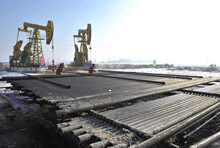
Typical street scene in Santa Ana, El Salvador. (Photo: iStock)
IMF Survey: Asia’s Swift Rebound Leads Global Recovery
April 24, 2010
- Asia’s faster recovery marks break from the past
- Capital inflows to Asia could raise risks of overheating in some economies
- IMF plans deeper Asia engagement, including July conference in Korea
A year after the deepest recession in recent history, Asia is leading the global recovery, with growth expected to average 7 percent across the region, the International Monetary Fund (IMF) says.

Steel pipes in Liaoning, China: global, domestic inventory cycle likely to boost Asia’s industrial production, exports further (photo: Mark/epa/Corbis)
IMF SPRING MEETINGS
China and India will again lead Asia’s growth, with 10 percent and 8.8 percent in 2010, respectively.
“The ‘green shoots’ of recovery that emerged in Asia earlier than elsewhere in 2009 have continued through the first months of 2010,” Anoop Singh, Director of the IMF’s Asia and Pacific Department, told reporters in Washington.
Key economic indicators are now growing at or above long-term trends, particularly in emerging Asian economies with large domestic demand bases such as China, India, and Indonesia, while there has been a V-shaped recovery in more export oriented economies. Asian low-income countries have well resisted the global crisis. .
The IMF will release its Regional Economic Outlook for Asia in the coming days in New Delhi and Shanghai. It is also organizing a high-level Asia and Pacific conference in Korea on July 12‒13, bringing together finance ministers, central bankers, heads of global and regional banks and companies, as well as prominent academics to strengthen the Fund’s engagement with all Asian economies.
Robust private demand
Singh said two factors will underpin Asia’s strong performance.
• The global and domestic inventory cycle is likely to boost Asia’s industrial production and exports further for most of 2010 as final demand recovers in advanced economies, especially the United States.
• Although macroeconomic policies may become less accommodative in the region, private domestic demand is expected to remain robust. High asset values, strong consumer confidence, and a gradual improvement in employment conditions are expected to sustain consumption, while the return of capacity utilization to more normal levels is expected to boost investment.
Better than in the past
Asia’s faster recovery relative to the rest of the world seems to mark a break from the past, Singh said.
This is the first time Asia is leading a global recovery; in all previous global downturns Asia’s contribution to global recovery was lower than that of other regions. Asia’s recovery in previous recessions generally was driven by exports, but this time, it also has been reinforced by resilient domestic demand.
And while in previous crises capital had been extremely slow to return to Asia, this time net capital inflows to the region have surged, a reflection of high levels of global liquidity, but also of Asia’s improved resilience and economic framework.
Some risks
At the same time, Asia’s stronger cyclical position may also pose near-term risks to the outlook—by further intensifying capital inflows to the region, Singh said.
Brighter economic growth prospects and widening interest rate differentials with advanced economies are likely to attract more capital into the region. This could lead to risks of overheating in some economies and increase their vulnerability to credit and asset price booms with the risk of subsequent abrupt reversals, he said.
Although asset price increases in Asia so far have been generally contained, with only a few local exceptions, the continuing increase in excess liquidity in many regional economies raises some concerns. Singh welcomed that policymakers have turned their attention to these risks and have already taken a variety of regulatory and macroeconomic measures to contain these risks.
Finding the right pace
The main near-term challenge for policymakers is judging the appropriate pace for normalizing monetary and fiscal policy. With Asia recovering faster than advanced economies, policy normalization in the region has already appropriately begun earlier than in several other parts of the world. At the same time, policymakers will have to consider the fragility of the global recovery, which argues for a cautious and gradual withdrawal of stimulus, Singh cautioned.
Monetary tightening may also pose the risk of attracting further capital inflows, which could complicate macroeconomic management. An appropriate response against this risk could involve a variety of measures, depending on circumstances, and include prudential regulations to slow runups in property and other asset prices; and more exchange-rate flexibility to forestall speculative capital inflows and avoid costly sterilization.
Rebalancing Asia’s growth
A key medium-term challenge for Asia is to devise structural policies that will allow a durable rebalancing toward domestic demand, Singh said.
To maintain rapid improvement in the standard of living, and increase the region’s resilience to external shocks, strengthening domestic sources of growth will be a strategic priority for many countries.
Depending on country circumstances, this will require comprehensive reform including measures to boost productivity in the service sector, to improve social services and reduce precautionary savings, to enhance financial markets and improve the investment climate, and to allow more exchange rate flexibility.


